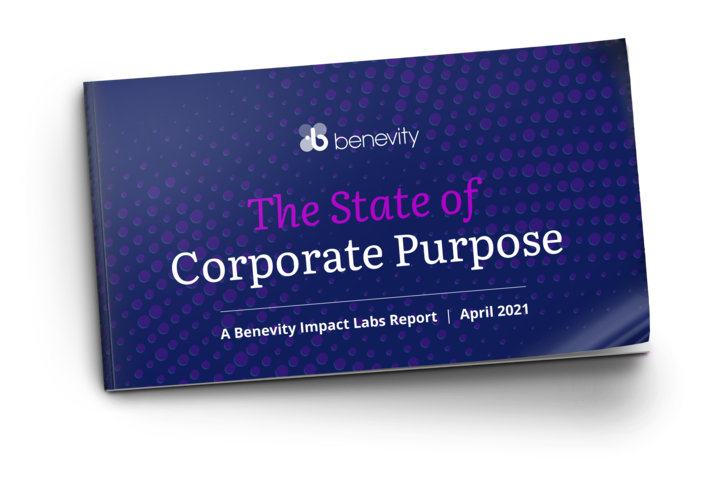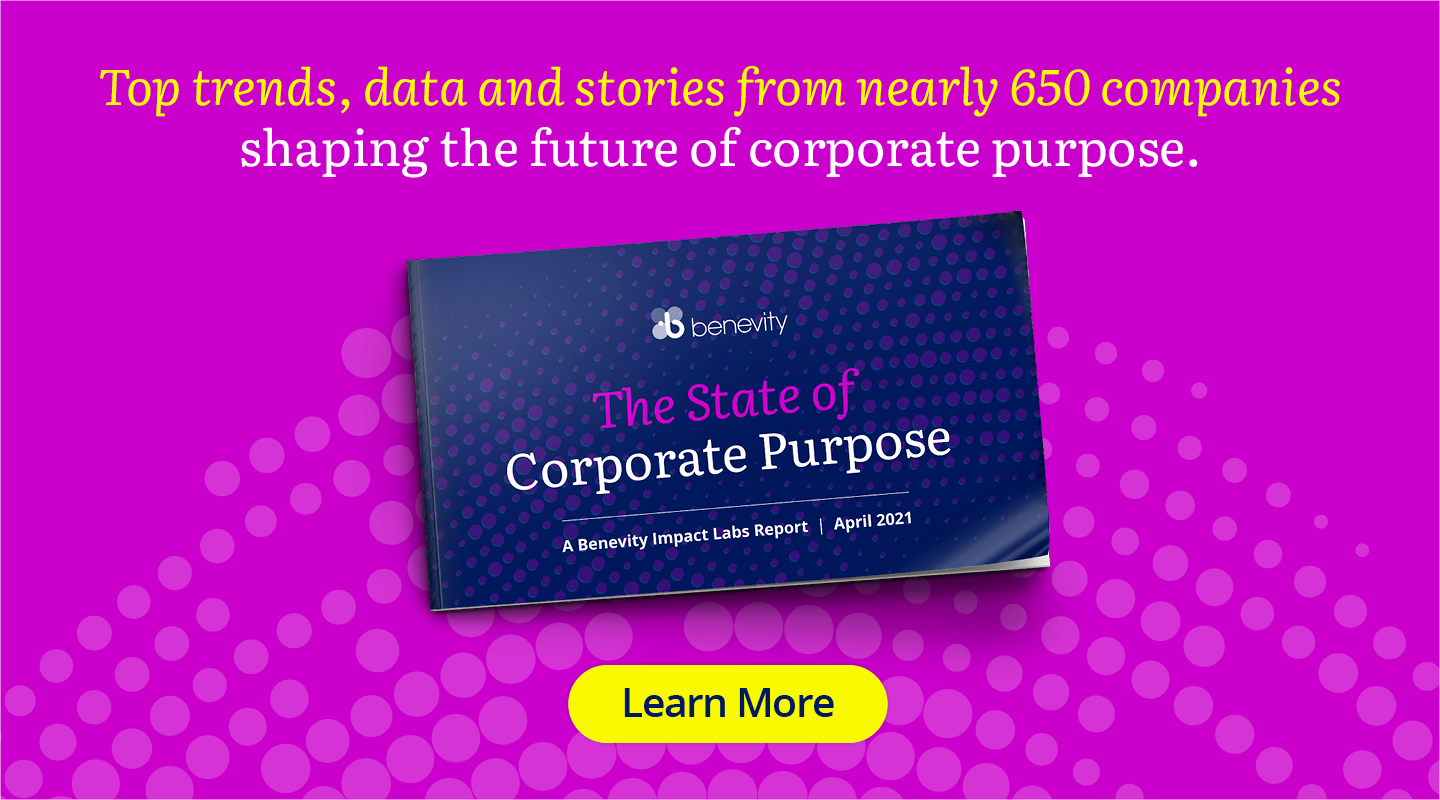This year, we saw seasonal donation trends disrupted as a result of the COVID-19 pandemic, which prompted a swift shift toward support for human services and food security from March through May. Then, an exponential spike in support for social justice and racial equity came
Traditional, top-down corporate philanthropy has been largely replaced with a more authentic and empowered approach in recent years. And, we were already beginning to see a notable rise in people-powered movements prior to 2020. But the recent crises and events sparked unprecedented grassroots action and 2020 became the year fueled by the power of the individual — backed by their employers and the brands they buy from — to create impact from the bottom up.
In a year of isolation and uncertainty, when people craved connection, meaning and efficacy, companies met people where they were. They provided the means and impetus to be okay with not being okay, to take action, to feel part of something bigger than themselves and their own challenges, and to gain a personal sense of purpose and impact.
Key moments lead to movements
in June following news of the killing of George Floyd and other Black people. By the end of the year, the “giving season” was in full swing, dispelling any concerns about donor fatigue slowing down giving in the latter part of the year.
The Pandemic Response
In just eight weeks following the announcement that COVID-19 had become a global pandemic, more than 500 companies and 450,000 of their people drove $640 million in donations, 786,000 volunteer hours, 53,000 small acts of Goodness and 8,648 corporate grants to support 79,000 global nonprofits. The most notable changes in the share of donation dollars among categories were in the categories of human services (+24%), food security (+268%), public safety and disaster preparedness/relief (+57%), community improvement (+57%) and employment (+141%).
Notable changes in causes supported during peak of COVID response*
The Racial Injustice Response
In June, a record was set for the most donations in a single month through the Benevity platform, with over $300 million going to 64,000 nonprofits. For the first time ever, organizations supporting social justice and racial equity made up nearly all of the Top 10 Causes for the month, and they accounted for 51% of June’s total donation volume, with $166 million contributed versus $10 million in May — a staggering 15x increase.
Countless more people got involved in other ways, tracking 434,000 volunteer hours (up 16% from May) and 29,000 positive actions (up 250% from May). And businesses engaged their customers, with funds donated through their Benevity-powered public giving portals to racial justice causes increasing by over 22x.
Unfortunately, funding for racial equity causes abated in the last half of the year, falling to just 5% of donation share in December, showing a gap between intention and action, and very likely driven by changes to the news cycle.
Racial Justice and Equity organization
Donation from May-Dec 2020
Special matching got more special in 2020
The vast majority of companies with corporate matching programs offer a 1:1 match year-round, with occasional special matches of 2:1 or even 3:1 or 4:1 during campaigns. In 2020, 84% of companies ran special matching campaigns beyond their standard year-round matching, with match rates reaching as high as 5:1. We know that when a match is offered, it leads to 80% higher average donation participation, but as we drilled into the data we discovered a “match multiplier effect” in which the higher the matching rate, the more dollars an individual gave.
Our data shows that these special matches led to 51% more people donating through their corporate purpose programs in 2020 versus 2019, and of those who did, they increased their personal contributions by 41%. The increase in individual donors corresponded with the crisis inflection points when most companies were running campaigns. New donors made up three to five times their normal share in the first seven months of 2020 and seven times their share in June.
“Thank you, Abbott, for your generosity and kindness in helping those impacted by the COVID-19 crisis. With my donation and Abbott's match, the Houston Food Bank will be able to offer an additional 2,000 meals. Finally, thank you Abbott researchers and scientists for the amazing contributions you've made during this pandemic!”
— Abbott Laboratories Employee
Peer-led movements took off
Benevity’s Peer Matching feature took off when it was launched in October 2020, providing individuals with the power to lead and amplify their own movements around causes they cared about personally. The feature was still in its early stages, but it proved to be the right solution at the right time for companies that had used up their yearly budgets or that didn’t want to ask their people to give yet again when donor fatigue was a concern.
The introduction of Peer Matching resulted in 4,630 individual peer matches being created, with $13 million in matching and $39 million in user donations, for a total of $52 million of collective impact. It also inspired 37,000 first-time participants who may have been looking for a sense of community and connection in an otherwise isolating time.
What is Peer Matching?
Peer Matching is the next innovation in matching. It enables individuals to create their own giving opportunities, add a match from their own funds and then open it up to their co-workers to either donate (and receive the match) or join the match pool. In this way, Peer Matching is a feature that empowers individuals to create a movement with their own funds based on their own passions.
People Are...
The Power of Payroll
In a year when finances may have been tight for some people, the ability to donate in small amounts was critical. For the first time, the number of companies offering payroll donations — which makes micro-donations easier for donors and more cost-effective for nonprofits — tipped over into the majority.
In 2020, 51% of companies offered payroll giving and 55% of all donations were made via payroll. Our data shows that when payroll giving is offered, companies see 53% higher average donation participation as it enables everyone to give in amounts and frequencies that are easily managed regardless of their personal banking situation or their desire or ability to donate using a credit card.
When crisis hit, content was queen
According to our client survey, corporate purpose professionals cited time and resource constraints as one of their biggest challenges in 2020. So, it’s unsurprising we saw a 50% year-over-year increase in the adoption of Benevity’s Content Streams, which serves up trending and popular cause recommendations as an easy way for people to join movements around newsworthy events.
Choice drove participation
and action
In what was a particularly difficult year for nonprofits, people continued to support personal and local causes they’re passionate about in categories not directly related to crisis response, including education, animal welfare, the arts and others. Notably, religious organizations appeared second only to human services in the causes most supported through public giving campaigns run by companies. And according to the Giving USA 2020 Report, giving to religious organizations grew 2.3% last year, while support for education, the arts, animals and the environment all saw double-digit growth.
This data highlights the fact that what people are passionate about in their personal lives transfers into how and where they want to give through a business relationship. More companies are beginning to recognize that offering broad choice in the types of causes people can support is essential to driving that engagement. That’s why 89% of companies include religious organizations in their programs, and when they do, they see 52% higher donation participation, 40% higher volunteer participation and a 14% higher terms of use acceptance rate, indicating that access to these causes inspires new participants to get involved.
Future movements will be
powered by people, propelled
by companies
In 2020, best practices became common practices: offering the choice of which nonprofits to support, incentivizing giving through special matching and donation currency rewards, and making donating easier and more accessible through payroll. And many companies went further to make special matches more special and in empowering their people to create their own giving opportunities and even add their own matching.
This past year showed us that individuals are capable of great things when they are empowered with the tools, technology and support they need to move from inertia to action. When they are able to rally their networks, they build momentum around causes and that leads to movements. As we continue to collectively tackle issues around equity, climate, health and well-being, and more, we will see people-powered movements becoming the standard, and the companies backing them will lead on every business metric.
Tips for including religious organizations
Our data shows a significant demand and opportunity for more companies to consider making religious causes available to donors — either with or without a match — as a way to deepen engagement. In Benevity’s platform, matching can be limited to community projects sponsored by churches or other religious organizations (such as food pantry programs) where the funds are solely directed to the specific project rather than the organization itself. This allows companies to include more of the nonprofits that people are clearly passionate about without supporting evangelical activities.

The 2020 Benevity Impact Report
Purpose has been recognized as a key component of long-term business resilience and sustainability — and it's driven a significant increase in all aspects of corporate purpose. The Benevity client community created record-breaking impact in 2020 and we're sharing all the details as part of The State of Corporate Purpose report.


